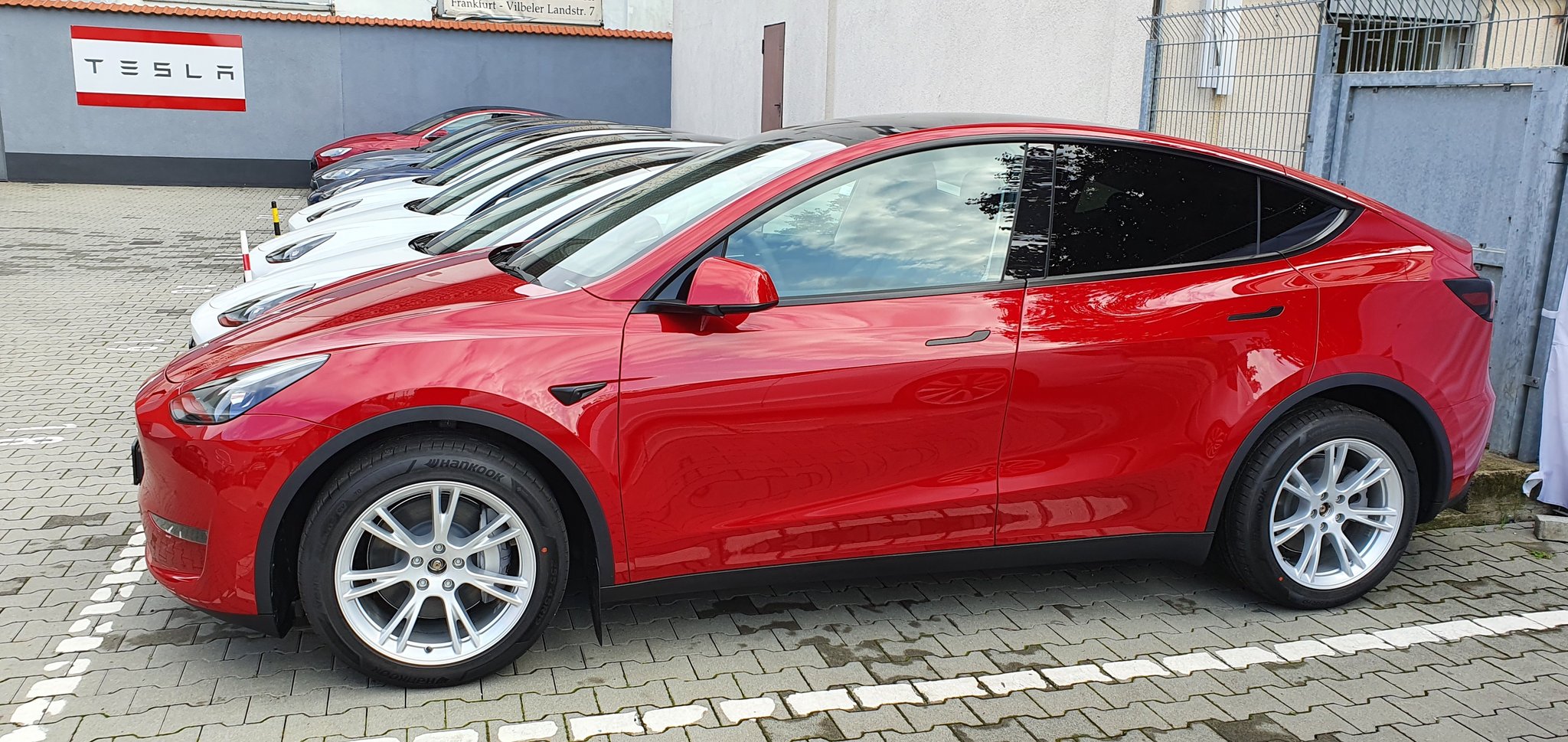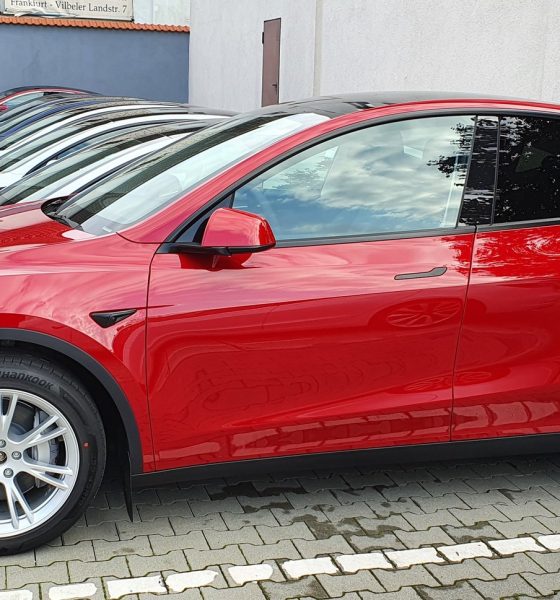

News
Tesla and other EVs’ strong sales helped drop Europe’s CO2 emissions in 2021
A recent report from market trend analysis firm JATO Dynamics has revealed that Tesla’s strong sales in Europe, coupled with the introduction of more environmentally-friendly SUVs, have helped drive a 16% reduction in CO2 emissions among new vehicles sold across the region in 2021.
JATO Dynamics’ findings were related in a report titled Driving the Change for Good: The EV Boom. According to the report, the volume-weighted average emissions of new vehicles across 17 markets in Europe dropped from 117.7g/km to 99g/km year-over-year. This drop happened to coincide with Tesla’s massive push into the electric market in Europe last year, which was made possible by exporting the Model 3 and Model Y from Gigafactory Shanghai in China.
It’s not just Tesla either, according to JATO’s report, as OEMs also showed a willingness to adopt more environmentally-friendly options in popular segments such as the SUV market. The analytics firm noted that prior to 2021, the lack of electric and even electrified SUVs in Europe was a limiting factor in the region. But in 2021, carmakers showed their willingness to meet consumer demand for green SUVs.
“The enhanced offering of new and improved electrified SUV models has further fuelled demand while also having a positive impact in reducing average CO2 emissions with midsize SUVs emerging as some of greenest vehicles in Europe,” the report read.
But while SUVs remained popular in Europe in 2021, other segments such as midsized cars also saw a reduction in CO2 emissions. This is where things get particularly interesting, as JATO noted that the drop in CO2 emissions among midsize cars was partly due to the strength of the Tesla Model 3, which became Europe’s most-registered midsize car in 2021. The Model 3 became very prolific in Europe last year, and the results were notable.
“There have also been interesting results across the traditional segments. For example, midsized cars (D-Segment) posted almost the same average as city cars, with 75.9 g/km compared to 76.9 g/km. This success is due to the Tesla Model 3 – the most registered midsize car in Europe in 2021 – with a volume increase of 64% compared with 2020. Last year, almost one in five D-segment cars registered in Europe was a Model 3, and this has started to have a real impact on the average emissions of the segment. In 2017, before the Model 3 arrived in Europe, the segment’s average was 120.1 g/km under NEDC,” JATO’s report read.
Amidst Europe’s focus on clean transportation, there appears to be a power shift among automakers that are operating in the region. With Tesla now being a very active player in the field, all-electric cars are positioned better than ever to expand their reach. The landscape would likely get even better for Tesla and electric vehicles in the near future as well, as Gigafactory Berlin has now started Model Y production.
“However, as a result of Tesla’s huge success since its arrival in Europe, we have seen a rebalancing of power. The popularity of the Tesla Model 3 and, more recently, the Model Y, pushed Tesla into the top 25 for the first time. With a record 165,700 units in Europe-17 and 169,200 across the whole region last year, Tesla became Europe’s preferred brand for electric vehicles. Overall, it was the 20th most registered make in 2021 and unsurprisingly, led the ranking of emissions by brand with 0.0 g/km.1,” the report read.
JATO Dynamics’ Driving the Change for Good: The EV Boom report can be accessed below.
JATO Consulting CO2 Report Full Year 2021 by Simon Alvarez on Scribd
Don’t hesitate to contact us with news tips. Just send a message to simon@teslarati.com to give us a heads up.

News
Tesla FSD fleet is nearing 7 billion total miles, including 2.5 billion city miles
As can be seen on Tesla’s official FSD webpage, vehicles equipped with the system have now navigated over 6.99 billion miles.

Tesla’s Full Self-Driving (Supervised) fleet is closing in on almost 7 billion total miles driven, as per data posted by the company on its official FSD webpage.
These figures hint at the massive scale of data fueling Tesla’s rapid FSD improvements, which have been quite notable as of late.
FSD mileage milestones
As can be seen on Tesla’s official FSD webpage, vehicles equipped with the system have now navigated over 6.99 billion miles. Tesla owner and avid FSD tester Whole Mars Catalog also shared a screenshot indicating that from the nearly 7 billion miles traveled by the FSD fleet, more than 2.5 billion miles were driven inside cities.
City miles are particularly valuable for complex urban scenarios like unprotected turns, pedestrian interactions, and traffic lights. This is also the difference-maker for FSD, as only complex solutions, such as Waymo’s self-driving taxis, operate similarly on inner-city streets. And even then, incidents such as the San Francisco blackouts have proven challenging for sensor-rich vehicles like Waymos.
Tesla’s data edge
Tesla has a number of advantages in the autonomous vehicle sector, one of which is the size of its fleet and the number of vehicles training FSD on real-world roads. Tesla’s nearly 7 billion FSD miles then allow the company to roll out updates that make its vehicles behave like they are being driven by experienced drivers, even if they are operating on their own.
So notable are Tesla’s improvements to FSD that NVIDIA Director of Robotics Jim Fan, after experiencing FSD v14, noted that the system is the first AI that passes what he described as a “Physical Turing Test.”
“Despite knowing exactly how robot learning works, I still find it magical watching the steering wheel turn by itself. First it feels surreal, next it becomes routine. Then, like the smartphone, taking it away actively hurts. This is how humanity gets rewired and glued to god-like technologies,” Fan wrote in a post on X.
News
Tesla starts showing how FSD will change lives in Europe
Local officials tested the system on narrow country roads and were impressed by FSD’s smooth, human-like driving, with some calling the service a game-changer for everyday life in areas that are far from urban centers.

Tesla has launched Europe’s first public shuttle service using Full Self-Driving (Supervised) in the rural Eifelkreis Bitburg-Prüm region of Germany, demonstrating how the technology can restore independence and mobility for people who struggle with limited transport options.
Local officials tested the system on narrow country roads and were impressed by FSD’s smooth, human-like driving, with some calling the service a game-changer for everyday life in areas that are far from urban centers.
Officials see real impact on rural residents
Arzfeld Mayor Johannes Kuhl and District Administrator Andreas Kruppert personally tested the Tesla shuttle service. This allowed them to see just how well FSD navigated winding lanes and rural roads confidently. Kruppert said, “Autonomous driving sounds like science fiction to many, but we simply see here that it works totally well in rural regions too.” Kuhl, for his part, also noted that FSD “feels like a very experienced driver.”
The pilot complements the area’s “Citizen Bus” program, which provides on-demand rides for elderly residents who can no longer drive themselves. Tesla Europe shared a video of a demonstration of the service, highlighting how FSD gives people their freedom back, even in places where public transport is not as prevalent.
What the Ministry for Economic Affairs and Transport says
Rhineland-Palatinate’s Minister Daniela Schmitt supported the project, praising the collaboration that made this “first of its kind in Europe” possible. As per the ministry, the rural rollout for the service shows FSD’s potential beyond major cities, and it delivers tangible benefits like grocery runs, doctor visits, and social connections for isolated residents.
“Reliable and flexible mobility is especially vital in rural areas. With the launch of a shuttle service using self-driving vehicles (FSD supervised) by Tesla in the Eifelkreis Bitburg-Prüm, an innovative pilot project is now getting underway that complements local community bus services. It is the first project of its kind in Europe.
“The result is a real gain for rural mobility: greater accessibility, more flexibility and tangible benefits for everyday life. A strong signal for innovation, cooperation and future-oriented mobility beyond urban centers,” the ministry wrote in a LinkedIn post.
News
Tesla China quietly posts Robotaxi-related job listing
Tesla China is currently seeking a Low Voltage Electrical Engineer to work on circuit board design for the company’s autonomous vehicles.

Tesla has posted a new job listing in Shanghai explicitly tied to its Robotaxi program, fueling speculation that the company is preparing to launch its dedicated autonomous ride-hailing service in China.
As noted in the listing, Tesla China is currently seeking a Low Voltage Electrical Engineer to work on circuit board design for the company’s autonomous vehicles.
Robotaxi-specific role
The listing, which was shared on social media platform X by industry watcher @tslaming, suggested that Tesla China is looking to fill the role urgently. The job listing itself specifically mentions that the person hired for the role will be working on the Low Voltage Hardware team, which would design the circuit boards that would serve as the nervous system of the Robotaxi.
Key tasks for the role, as indicated in the job listing, include collaboration with PCB layout, firmware, mechanical, program management, and validation teams, among other responsibilities. The role is based in Shanghai.
China Robotaxi launch
China represents a massive potential market for robotaxis, with its dense urban centers and supportive policies in select cities. Tesla has limited permission to roll out FSD in the country, though despite this, its vehicles have been hailed as among the best in the market when it comes to autonomous features. So far, at least, it appears that China supports Tesla’s FSD and Robotaxi rollout.
This was hinted at in November, when Tesla brought the Cybercab to the 8th China International Import Expo (CIIE) in Shanghai, marking the first time that the autonomous two-seater was brought to the Asia-Pacific region. The vehicle, despite not having a release date in China, received a significant amount of interest among the event’s attendees.








